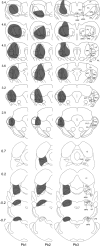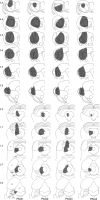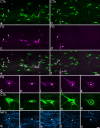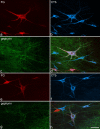Collateral projections of neurons in laminae I, III, and IV of rat spinal cord to thalamus, periaqueductal gray matter, and lateral parabrachial area
- PMID: 19496168
- PMCID: PMC2729698
- DOI: 10.1002/cne.22081
Collateral projections of neurons in laminae I, III, and IV of rat spinal cord to thalamus, periaqueductal gray matter, and lateral parabrachial area
Abstract
Projection neurons in lamina I, together with those in laminae III-IV that express the neurokinin 1 receptor (NK1r), form a major route through which nociceptive information reaches the brain. Axons of these cells innervate various targets, including thalamus, periaqueductal gray matter (PAG), and lateral parabrachial area (LPb), and many cells project to more than one target. The aims of this study were to quantify projections from cervical enlargement to PAG and LPb, to determine the proportion of spinothalamic neurons at lumbar and cervical levels that were labelled from PAG and LPb, and to investigate morphological differences between projection populations. The C7 segment contained fewer lamina I spinoparabrachial cells than L4, but a similar number of spino-PAG cells. Virtually all spinothalamic lamina I neurons at both levels were labelled from LPb and between one-third and one-half from PAG. This suggests that significant numbers project to all three targets. Spinothalamic lamina I neurons differed from those labelled only from LPb in that they were generally larger, were more often multipolar, and (in cervical enlargement) had stronger NK1r immunoreactivity. Most lamina III/IV NK1r cells at both levels projected to LPb, but few were labelled from PAG. The great majority of these cells in C7 and over one-fourth of those in L4 were spinothalamic, and at each level some projected to both thalamus and LPb. These results confirm that neurons in these laminae have extensive collateral projections and suggest that different neuronal subpopulations in lamina I have characteristic patterns of supraspinal projection.
(c) 2009 Wiley-Liss, Inc.
Figures









References
-
- Almarestani L, Waters SM, Krause JE, Bennett GJ, Ribeiro-da-Silva A. Morphological characterization of spinal cord dorsal horn lamina I neurons projecting to the parabrachial nucleus in the rat. J Comp Neurol. 2007;504:287–297. - PubMed
-
- Basbaum AI. Conduction of the effects of noxious stimulation by short-fiber multisynaptic systems of the spinal cord in the rat. Exp Neurol. 1973;40:699–716. - PubMed
-
- Becker CM, Hoch W, Betz H. Sensitive immunoassay shows selective association of peripheral and integral membrane proteins of the inhibitory glycine receptor complex. J Neurochem. 1989;53:124–131. - PubMed
-
- Beitz AJ. The organization of afferent projections to the midbrain periaqueductal gray of the rat. Neuroscience. 1982;7:133–159. - PubMed
Publication types
MeSH terms
Substances
Grants and funding
LinkOut - more resources
Full Text Sources
Miscellaneous

